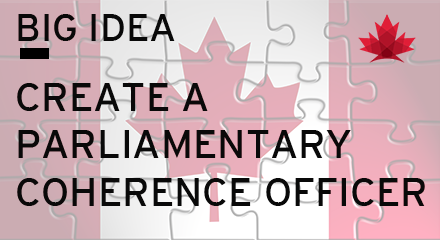
In June, Canada 2020 launched The Innovation Project, an initiative devoted to studying Canada’s innovation agenda – the risks, the opportunities, and key factors involved in making Canada a more innovative nation.
As part of this project, we asked Mike Moffatt, Senior Associate at Canada 2020 and Director at the Lawrence Centre at Western University’s Ivey Business School and Hannah Rasmussen, Director at Projection North and Professor at Western University’s Brescia College, to consider how to foster innovative growth in Canada.
Moffatt and the Canada 2020 team traveled to eight cities across Canada to hold roundtable discussions with key stakeholders representing sectors ripe for transformation. We are grateful for the thoughtful discussion and time these roundtable participants gave the effort. While the sectors themselves were very different, common themes emerged: talent and immigration, availability of venture capital and Canadians’ adversity to risk.
From their research and these roundtables, Moffatt and Rasmussen developed 10 Big Ideas for Canada. Canada 2020 will be releasing an idea a day on our website leading up to our 3rd Annual Canada 2020 Conference.
Each idea is thoughtful and detailed, and Canada 2020 hopes they will spur discussion and debate on the topic as we continue to explore innovation in Canada.
—
Big Idea: Reform Immigration with a Focus on Tradable Sectors
What is the idea?
Canada’s immigration system is incredibly complex, with more than 60 different programs that admit non-Canadians to the country. A detailed description of each is well beyond the scope of this report, so our recommendations will be at a high level. Our immigration recommendations revolve around one core point: the system as a whole needs to make a larger distinction between tradable and non-tradable sectors of the economy, and focus on bringing in workers with skills valued in tradable sectors.
Recommendation: Canada’s economic immigrant programs, for both permanent and non-permanent immigrants, should have the expressed mandate of raising wages and economic opportunities for Canadians, which they can accomplish through a focus on tradable sectors.
To explain the idea, we first need to understand what tradable sectors are and, secondly, we need to understand why the distinction matters. To address the first issue, we will use the Australian Bureau of Statistics definition of tradable sectors.
Tradable sector: “A domestically produced good or service is defined as tradable if it is actually traded internationally, or it could be traded at some plausible variation in relative prices — this includes domestically produced goods and services which replace imports in the domestic market.” (1) Illustrating the importance of the distinction between tradable and non-tradable when examining employment dynamics in a local economy is best done through the use of examples from the services industry.
First, consider Saskatoon’s technology sector, specifically companies that program applications or design video games. Because their products are purchased by users all over the world, these companies are competing against companies from Bangalore to Helsinki; their competition is not other companies in Saskatoon. As such, the size of Saskatoon’s tech cluster can grow arbitrarily large because the market is worldwide and the success of one local company does not come at the expense of another. Because the industry can grow arbitrarily large, it can absorb additional workers without any downward pressure on wages, and may even raise wages in the sector as a thicker labour market attracts tech companies to Saskatoon. Furthermore, the success of a local tech company brings in outside capital and creates employment opportunities in other industries. In The New Geography of Jobs(2) economist Enrico Moretti found that one additional job in the tech sector creates five additional jobs in the economy at a variety of different skill levels. Moretti defended the five-to-one ratio in an interview with Stanford’s Kathleen O’Toole:(3)
The way to interpret the multiplier is to imagine dropping 1,000 innovation jobs in one city but not in another, and then going back 10 years later to measure how many additional local service jobs there are in the city that experienced that innovation-sector drop of jobs. So it’s a long-run effect, but it’s not impossible for three reasons.
One is that the average high-tech worker tends to do very, very well, and people who are wealthy tend to spend a large fraction of their salary on personal and local services. They tend to go to restaurants and movies, and to use taxis and therapists and doctors on average more than people who are paid less.
The second reason is high-tech companies themselves employ a lot of local services; everything from security guards to IP lawyers, from the janitor to the very specialized consultant. High-tech companies tend to use more services than manufacturing companies.
The third reason is the clustering effect. Once you attract one of those high-tech workers, then in the medium to long run, you’re going to be attracting even more of those high-tech workers and companies, which will further increase your multiplier. So it’s a long-run number, measured over a 10-year period.
Contrast this with the market for brick-and-mortar drugstore pharmacists in Saskatoon. Pharmacists at brick-and-mortar drugstores provide a non-tradable service, as their customers are local in nature.
While the number of pharmacists in Saskatoon is not fixed, it can only grow so large, as there is a limit to how many pharmacists the local market can reasonably absorb. As such, firms in the market grow and increase revenue more by seizing market share from their competitors than from growing the overall size of the local market. Due to these constraints, a sudden and significant influx of pharmacists to the Saskatoon market would drive down wages and increase unemployment as the local market would not be able to fully absorb the increase due to the non-tradable nature of brick-and-mortar pharmacy services.
Beyond Moretti’s findings, there is empirical evidence to support the wage effects of immigration on tradable and non-tradable sectors. While there is a substantial body of literature showing that, in many cases, higher levels of immigration do not lead to lower wages on average,(4) this does not necessarily mean that the effect of higher levels of immigration is identical across industries. A recent study by the Bank of England found that the impact of immigration differs across industries, and that “the biggest effect is in the semi/unskilled services sector, where a 10 percentage point rise in the proportion of immigrants is associated with a 2 percent reduction in pay.”(5) The fact that these people disproportionately work in non-tradable sectors supports the theory of the differing effect of immigration on employment and wages between the sectors.(6)
Canada requires high levels of immigration to address demographic challenges and ensure that it has the skilled workers necessary to compete globally in tradable sectors. If it brings in too many workers from non-tradable sectors and drives down wages and opportunities in some industries, it risks a public backlash that puts Canada’s immigration goals in jeopardy. We need only look at Brexit and the backlash against “Polish plumbers” to see how antipathy towards immigration is often related to employment in non-tradable sectors.
There are Canadian examples of the immigration system being used to prevent wages from rising in non-tradable sectors. The Temporary Foreign Worker program is a prime example. Through an Access to Information request, the Alberta Federation of Labour found that “between April 25 and December 18, 2012, more than 2,400 ALMO [Accelerated Labour Market Opinion] guest-worker permits — which are supposed to be reserved for highly skilled employment — have been granted to fast-food restaurants, convenience stores and gas stations.”(7) By bringing in these workers, Canada is holding down wage increases to low-income workers. While it is possible that some of these jobs could be uneconomical at higher wages, these are not the type of jobs that create spin-off jobs through increased flows of foreign capital.
In a 2014 Toronto Star editorial,(8) Liberal Leader Justin Trudeau suggested some reforms to the Temporary Foreign Worker Program to deal with the economic effects it has on Canadian workers as well as the possibility of exploitation of guest workers; two of those recommendations continue to have value today.
Recommendation: The auditor general should conduct a full review of the Temporary Foreign Worker Program.
Recommendation: Transparency of the Temporary Foreign Worker Program should be increased, with public disclosure of applications and approval data.
When implementing policy, one must worry about unintended consequences. One way firms could deal with restrictions on temporary foreign workers is to turn those positions into unpaid internships. These internships are problematic from an equality of opportunity perspective, as the opportunities created can only be obtained by those who can afford to work for free. Because of this, unpaid internships are illegal in Ontario unless a very restrictive set of conditions is met.(9) In some other provinces, regulations are vague about the legality of unpaid internships.(10) This leads us to the following recommendation:
Recommendation: Provincial governments should explicitly ban unpaid internships and increase their enforcement of existing regulations in the area. The federal government should do likewise for federally regulated industries.
Meanwhile, while fast-food companies and gas stations were able to bring in temporary foreign workers, export-oriented high-growth companies were unable to obtain and retain the workers they needed. Companies that have hired foreign graduates of Canadian schools under the Post Graduation Work Permit Program are seeing these workers deported as companies struggle to navigate a byzantine set of rules.(11) Tech companies in London, Ont., report they have opened offices in the United States since they have found regulatory barriers make it too difficult to bring talent north of the border.(12) Other companies at our tech roundtable held this past summer have moved operations outside of Canada, and taken Canadian workers with them, to be able to access the talent they need. The tax revenue these companies generate and the spin-off jobs they create could be going to Ontario but are instead going to California, simply for regulatory reasons. This needs to stop.
Recommendation: Immigration, Refugees and Citizenship Canada should streamline the process for companies in export-oriented goods and service industries wishing to recruit or retain skilled workers.
By focusing our immigration system on tradable sectors and away from non-tradable sectors, we can attract and retain talent in Canada, increase the competitiveness of our export industries and increase wages and job opportunities for Canadians.
Although our focus to this point has been on wages, reforming our immigration system with a focus on tradable sectors creates an environment for innovation, as described by the Expert Panel on Business Innovation in 2009:
Canada’s domestic market is relatively small and geographically fragmented. Small markets are less conducive to innovation than large markets (like the United States) because
i. they offer lower potential reward for undertaking the risk of innovation, and
ii. they tend to attract fewer competitors and thus provide less incentive for a business to innovate in order to survive. (The Canadian domestic market is relatively “cushioned” and pre-tax business profitability, as a percentage of GDP, has exceeded that of the United States in most years since 1961.)
The innovation success of countries like Finland and Sweden shows, on the other hand, that the disadvantage of a small domestic market can be offset by a strong orientation toward innovation-intensive exports.(13)
Canadians need higher wages and more opportunities and Canada needs to be more innovative. Through restructuring Canadian immigration programs, we can simultaneously accomplish both.
Who will be responsible for administering the idea?
Immigration is a federal responsibility, with the exception of Provincial Nominee Programs and the Canada-Quebec accord. Immigration falls under the jurisdiction of Immigration, Refugees and Citizenship Canada with some exceptions, such as the Temporary Foreign Worker Program, which is jointly administered by Immigration, Refugees and Citizenship Canada and Employment and Social Development Canada.
What mechanisms for accountability or measurement can be put in place for the idea?
Beyond the recommendations given earlier on accountability measures that should be put in place for the Temporary Foreign Worker Program, we recommend the following:
Recommendation: The federal government should conduct a study on the impact of immigration on Canadian occupational wages, similar to the Bank of England study.
Recommendation: The Office of the Parliamentary Coherence Officer, after it is created, should conduct a thorough review of the coherence of Canada’s immigration sector as it relates to the mandate of raising wages and economic opportunities for Canadians.
Recommendation: Statistics Canada should strengthen its collection of labour market data, with a focus on labour market outcomes by industry for immigrants and non-immigrants.
What failures is the idea trying to solve?
Thin Markets: A shortage of skilled workers limits the growth of innovative companies in fast-growing clusters such as the Kitchener-Waterloo tech sector. The complexity of regulations along with processing times cause issues for companies, a point Immigration Minister John McCallum recognized in a Globe and Mail interview when he stated: “Tech firms’ idea of a quick immigration processing time is more like six days rather than six months … for us six days would be a stretch… but at the same time … we want to open our doors to the best and the brightest … so, obviously, I will be working very hard to try to accommodate their needs as best I can.”(14)
These problems hit clusters in small and mid-sized cities particularly hard, as they do not have large local networks of immigration lawyers and experts from which to draw experience. One advantage that clusters in mid-sized Canadian cities should have is the significant number of international students that study in their colleges and universities. However, companies report that it is difficult to retain these individuals after the expiry of their Post-Graduation Work Permits.(15)
Inequality of Opportunity: The poor design of some immigration programs, most notably the Temporary Foreign Worker Program, prevents wages from rising in non-tradable sectors and limits job opportunities for low-income Canadians. Well-designed immigration reforms will disproportionately benefit workers who are the most marginally attached to the labour force.
What are the potential benefits of the idea and what are the costs?
Benefits: A successful reform of Canada’s immigration systems to focus on tradable sectors has three big benefits:
- Industry clusters that grow faster export more and create additional wealth.
- Spin-off wealth and prosperity in non-tradable sectors that support those clusters.
- Increased wages and job opportunities for Canadians in non-tradable sectors due to reduced competition for these positions.
Costs and Risks: If the plan works as intended, wages should increase in the non-tradable sector. Of course, this also likely means that the price of goods and services will rise accordingly. Furthermore, it could cause skills shortages in certain non-tradable sectors.
The largest issue is that this plan could fail or have unintended consequences for a variety of different reasons. Changes to immigration policies are tricky, and there is no guarantee that governments get it right. The biggest potential roadblock is that the plan requires governments to be able to distinguish between job types that are largely in the tradable sector and those that are not.
Will the idea increase economic inclusion and/or enhance autonomy? If so, how?
Economic Inclusion: By refocusing our immigration policies to tradable sectors, we can ensure that government policies are not reducing wages and limiting economic opportunities for Canadians. Furthermore, due to the positive employment spillovers created by high-skilled immigrants in tradable sectors, wages and employment opportunities are increased for everyone from lawyers to barbers to construction workers. Our immigration system should have as an explicitly stated core goal of increasing wages and job opportunities for Canadians.
Autonomy: At first glance, there appears to be little relationship between the proposed immigration changes and the level of personal autonomy for Canadians. However, a booming tradables sector creates job opportunities and business opportunities for current Canadians in non-tradable sectors. These opportunities could be amplified with enhanced non-tradable sector skills training for individuals that are unemployed or out of the labour force.
Footnotes
1 Australian Bureau of Statistics, Australia’s Tradable Sector (1996)
2 Enrico Moretti, The New Geography of Jobs (Houghton Mifflin Harcourt, 2012)
3 Kathleen O’Toole, “Enrico Moretti: The Geography of Jobs,” Insights by Stanford Business, (2013).
4 A useful discussion of the literature appears in “Immigration, Wages and Compositional Amenities,”
David Card, Christian Dustmann and Ian Preston, Journal of European Economic Association (2011).
5 Stephen Nickell and Jumana Saleheen, “The impact of immigration on occupational wages:
evidence from Britain,” Bank of England: Staff Working Paper No. 574 (2015).
6 For the purposes of their paper, Nickell & Saleheen, (2015) define the semi/unskilled services sector as including child-minders, early childhood educators, animal care assistants, housekeepers, travel agents/assistants, caretakers, sales assistants, check-out staff, call centre staff, postmen, shelf fillers, car park attenders, cleaners, road sweepers, bar staff, porters and waiters. These jobs are largely non-tradable in nature, with some exceptions such as call centre staff.
7 Alberta Federation of Labour, List of ‘accelerated’ TFW approvals reveals widespread abuse of program (2013).
8 Justin Trudeau, “How to fix the broken temporary foreign worker program,” The Toronto Star, May 5, 2014.
9 Ontario Ministry of Labour, “Are Unpaid Internships Legal in Ontario?” Ontario Ministry of Labour website (2011).
10 Canadian Intern Association, What is the law? (2016).
11 Ronalee Carey, “Express Entry and International Students, Is there a Disadvantage?” Ronalee Carey Law (2015).
12 Michael P. Moffatt and Rachel Parker, “We asked a group of tech executives: ‘What does it take to grow in London, Ontario?’ ” Mowat Centre (2015).
13 Expert Panel on Business Innovation. Council of Canadian Academies, Innovation and Business Strategy: Why Canada Falls Short (2009).
14 Sean Silcoff and Michelle Zilio, “Ottawa vows to cut wait times for foreign workers joining tech firm,” Globe and Mail, Tuesday, June 14, 2016.
15 This is discussed in detail in “Canada’s hardest-hit economies need immigration to thrive again,” Mike Moffatt, Canadian Business, February 16, 2016.



 clusters like the ones in Silicon Valley, Berlin, Tel Aviv and the Toronto-Waterloo corridor contribute significantly to both regional and national economies.
clusters like the ones in Silicon Valley, Berlin, Tel Aviv and the Toronto-Waterloo corridor contribute significantly to both regional and national economies.

 In June, Canada 2020 launched The Innovation Project, an initiative devoted to studying Canada’s innovation agenda – the risks, the opportunities, and key factors involved in making Canada a more innovative nation.
In June, Canada 2020 launched The Innovation Project, an initiative devoted to studying Canada’s innovation agenda – the risks, the opportunities, and key factors involved in making Canada a more innovative nation.

